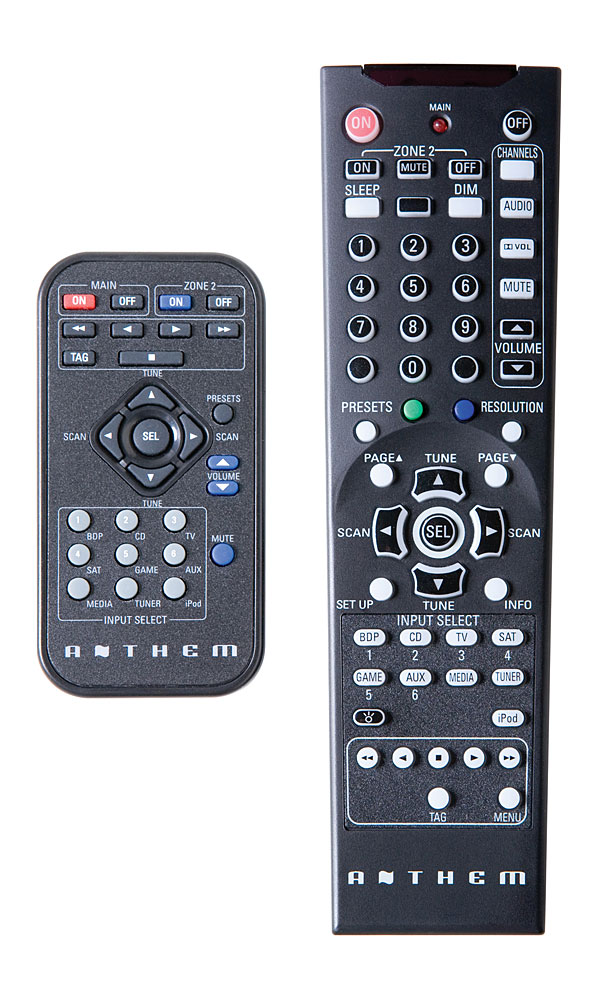You state that the MRX 300 has 4 in/2 outputs for HDMI; yet the photo of the back only shows ONE HDMI output. Is this an early photo of a pre-production model or an error?
Anthem MRX 300 A/V Receiver Page 2
The More Correct Correction
Perhaps the most significant—and certainly the most distinctive—feature in Anthem A/V receivers is ARC, Anthem Room Correction, as derived from the company’s world-beating surround processors. Proprietary auto setup and room correction schemes are sometimes dodgy in practice. But ARC is serious stuff and much acclaimed in Anthem’s processors. The AVR comes supplied with a setup microphone that’s shaped not like a chocolate kiss but like a real mike. Anthem also provides a tripod, in case you don’t have one. The Anthem people have left nothing to chance: Knowing that setup microphones have sample-to-sample variations, they’ve custom-matched and serial-numbered each one to correspond to support files on a supplied CD.

To set up ARC, you’ll need a PC running Windows XP or higher, or an Intel-based Mac running Bootcamp. You’ll connect your computer to the microphone via a supplied USB cable and to the AVR via a supplied serial cable. If your computer doesn’t have a serial port—most don’t, nowadays—Anthem dealers offer a Keyspan serial-to-USB adapter ($29). I received mine separately from my review sample. If you buy an Anthem ARC product, make sure you get the adapter.
I booted up my trusty ThinkPad T61 XP laptop and loaded both the ARC software and the serial adapter software from their supplied CDs. Before the test tones sounded, I instructed the ARC software that I was using a 5.1-channel speaker configuration, with no back-surround or height channels, and I selected the microphone’s serial number from a menu (it was the only possible selection). ARC measures from a minimum of five positions, which was really two more than I needed, and a maximum of ten. The rapid low-to-high sweep tones were loud enough to warrant wearing my Howard Leight ear protectors. The toddler down the hall might have thought Martians were having a laser-gun fight in my living room.
During the ARC setup, you can perform different measurements for movies and music, or apply a single setting to both. When the process is over, you can set ARC to on or off for each source input. I was interested to note that ARC selected a 60-hertz crossover for my subwoofer, in lieu of the 80 Hz I would normally pick given my speakers’ bass rolloff. I stuck with ARC’s decision.
Associated equipment included five Paradigm Reference Studio 20 v.4 speakers. Also in the loop was a Paradigm Seismic 110 subwoofer, with its internal PBK EQ off, so it wouldn’t interact with the Anthem’s ARC. The main signal source was an OPPO BDP-83SE universal disc player, although I also used a Rega Planar 25 turntable with a Shure M97xE cartridge and a Bellari VP530 phono preamp. All movie demos were Blu-ray Discs with DTS-HD Master Audio soundtracks.
A/B-ing Dolby Volume
The ARC-corrected A/V receiver presented a crisp top end in Hereafter, with Matt Damon as a retired psychic trying to find his way in the world. Highlights came early on. An idyllic outdoor-market scene gave the AVR a chance to flaunt its soundfield with the murmur of a happy crowd and the twittering of birds. I had an unusually strong sensation of being there. Then a tsunami crashed into the scene.Given recent events in Japan, it wasn’t easy to watch. The loud, roaring, crunching effects drove me to invoke Dolby Volume at a relatively low setting. While there weren’t any subsequent aggressive effects, Dolby Volume did a fine job of keeping the dialogue, much of it hushed, intelligible.
Black Swan is a ballet epic with Natalie Portman as an ambition-tormented dancer. Orchestra and piano appeared in various guises. The piano accompaniment in a dance studio was suitably reverb-rich—not in a showy way, just the natural tinkle of the instrument in a large room full of hard surfaces. The Anthem brought this across quite convincingly. The orchestra, infused into the movie’s most emotionally charged scenes, had a strong cutting edge, not a warm feel-good sound. I continued to use Dolby Volume and got good results.
- Log in or register to post comments


Pretty sure the picture on page 3 is the inside of the 700. I didn't think a $1000 receiver would have a toroidal transformer.

I was reluctant to buy this model since I'm running 7 channels and my speakers are rated at 100w (8ohms). When I read that your tests had positive results with the Paradigm Studios, it convinced me to get one.
I am extremely pleased with its performance. The sound is much fuller and more detailed than my previous receiver which had a lot more bells and whistles that I never used, and rated at almost twice the output.
Is there better room correction than ARC? Wow!
Thanks again.

Good Day,
I intent to upgrade my Pioneer VSX-LX53 Receiver.I'll be using Klipsch RF-52 II Floorstanders,RC-62 II Centre,RS-42 II Rears and Energy S10.3 Subwoofer.
I'm tossed between these two Receivers.
Secondly is it possible to use a Pro Sound Power Amp such as the Samson SX-1800 with any of these two units.It's rated at about 300W RMS per channel into 8 Ohms.The accompany prescribe PVA-5 for use with the MRX-300 is a bit expensive.
Regards
Alan
































































